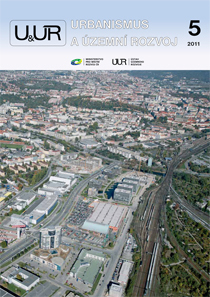
Comparative Analysis of Technical and Cartographical Aspects of Spatial Planning in GIS and CAD Environments, by Jaroslav Burian & Anna Ferklová
This article describes a comparative analysis of how spatial plans on the territory of the Czech Republic are produced in GIS and CAD environments. Based on research of various methodologies of spatial planning, a questionnaire was designed in order to survey how spatial plans are created from a technical point of view. Using the questionnaire survey and consultations with spatial planners, technical and cartographical procedures for the graphic elaboration of spatial plans were compared and described. Also based on such consultations, the quantification and evaluation of some specific steps in the creation of spatial plans was performed, highlighting the differences between GIS and CAD environments in the usage of data provided by documents of spatial analysis. For the practical section of the analysis, the graphic part of the spatial plan of the town of Náměšť na Hané was elaborated, with the use of MINIS methodology, in both environments. In conclusion, some important problems of visualization in spatial planning in GIS and CAD environments are specified, with proposals for their efficient solution.
The Suburbanization of Olomouc: Assessment through Statistical Data Analysis, by Jaroslav Burian, Jakub Miřijovský and Markéta Macková
This article describes one of the possible approaches to the study of suburbanization of the town of Olomouc, commenting on its manifestations and attempting a definition. In the description of the suburbanization process in the theoretical part, some basic approaches to its analysis are mentioned. Particular attention is devoted to statistical data used for the study. Based on the principle of functional urban areas, the spatial and temporal delimitation of the suburbanization of the region is defined first. Then the authors describe a partially automatic procedure that uses the mathematical methods of multicriteria assessment within the ArcGIS environment for the identification of the rate of suburbanization in various settlements of the region. Finally there is a description of the state of suburbanization in selected municipalities in the region.
In Front of the Brno Railway Station: a Pedestrian’s View of the Zone, by Lucie Galčanová, Robert Osman and Barbora Vacková
This contribution presents the results of an analysis focusing on the zone outside the main railway station in Brno. The analysis was carried out on behalf of the Municipality of Brno, supported by Hnutí Duha, a leading Czech NGO, and the Partnerství foundation. The objective of the assignment was to gather information that could be used for the improvement of this zone. In order to find out how this zone is perceived by users of the location, a combination of sociological and geographic methods of qualitative research was applied. Suggestions for the improvement of this public area arising from the analysis of material obtained from the data are briefly summarized at the end of the article.
The Danube Area, its Delimitation and Characteristics, by Milan Körner
This article addresses information about EU strategy for the Danube Area as a region for the 21st century. It studies the history of this territory, its population structure, transportation links and, in particular, its differing economic and social characteristics, discussing the difficult application of general development strategies for such a large territory, which shows great variation in a lot of aspects.
Housing Construction on the Territory of the Prague Metropolitan Region from 2005 to 2010 and an Estimation of its Development to 2016, by Michal Němec
Traditionally, the metropolitan region of Prague is the place of the most intensive housing construction in the Czech Republic. When the period 2005 to 2010 is compared with the previous decade, this is seen as an extraordinary time in terms of the volume of completed constructions. The bonds between the city of Prague and its hinterland go beyond the Districts of Praha-východ and Praha-západ to more distant Districts within the Region of Central Bohemia, thus constituting an area of intense spatial relations, quantifiable in statistical data on migration, commuting to work and schools, intensity of cooperational production links, and so on. In the last 10 or 15 years, such intense spatial relations between Prague and its hinterland can also be seen in housing and housing construction, as is manifested in the heavy suburbanization which became an important phenomenon in the shaping of the Prague metropolitan region.
Viktor Rudiš: an Interview with a Great Architect and Urban Planner
Creator or co-creator of a lot of important works, such as the Brno’s Lesná housing estate (1961–1968), the Czechoslovak Hall at EXPO 1970 in Osaka (1969–1970), apartment buildings in Litomyšl (1995), the reconstruction and completion of Hall G at the Brno Exhibition Centre (1995–1996) and the reconstruction of the Brno Museum of Applied Arts (1998–2001), the architect and urban planner Viktor Rudiš (84) certainly does not look his age. Although he has retired from active planning, we continue to encounter the name Rudiš, as Viktor’s son Martin continues the architectural practice he and his father founded after the Velvet Revolution of 1989. Viktor Rudiš is laureate of a number of awards, the most recent of which, the 2010 Tribute of the Czech Chamber of Architects, was the motive for our interview.